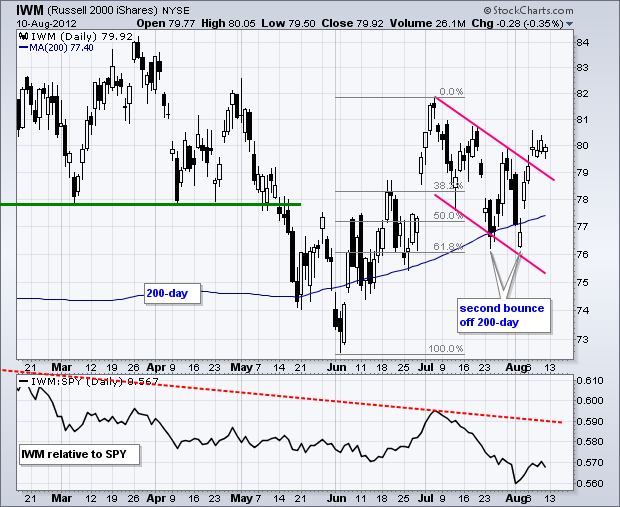Stocks continued higher last week and closed near their highs for the week. The Nasdaq 100 ETF broke resistance from its July highs and this breakout is holding. The Russell 2000 ETF broke falling channel resistance and this breakout is holding. The Dow Industrials is one of the strongest as it challenges its April highs. Despite a bullish environment, the major index ETFs are short-term overbought and I remain concerned with relative weakness in small-caps. The IWM:SPY ratio bounce in early August, but remains in an downtrend overall with a lower low just last week.
It will be a big week for retail because retail sales will be reported on Tuesday morning. Steve Reynolds, of Craig Drill Capital, noted that resilience of the American consumer was second only to the cockroach. Consumers will get a chance to prove themselves on Tuesday. The Retail SPDR (XRT) chart looks similar to the Russell 2000 ETF above. XRT broke falling wedge resistance and the breakout is holding. However, the stock is stalling just above the breakout and the price relative remains in a downtrend. XRT is getting cold feet and showing relative weakness. While this is not a good combination, the breakout is holding and it would take a move below 59.5 to suggest otherwise.

The S&P 500 ETF (SPY) remains in a clear uptrend as it consolidates above its late July high. This flat consolidation looks like a high and tight flag. Technically, a break above 141 would signal a continuation higher. The flag lows mark first support and a break below this level would argue for a pullback or minor correction. Should SPY break support here, I would mark the next support zone around 138.5-139. Support here stems from broken resistance and the top of the gap zone. 40-period RSI has been in bull mode since mid June because it remains above 40, which marks uptrend support for momentum.
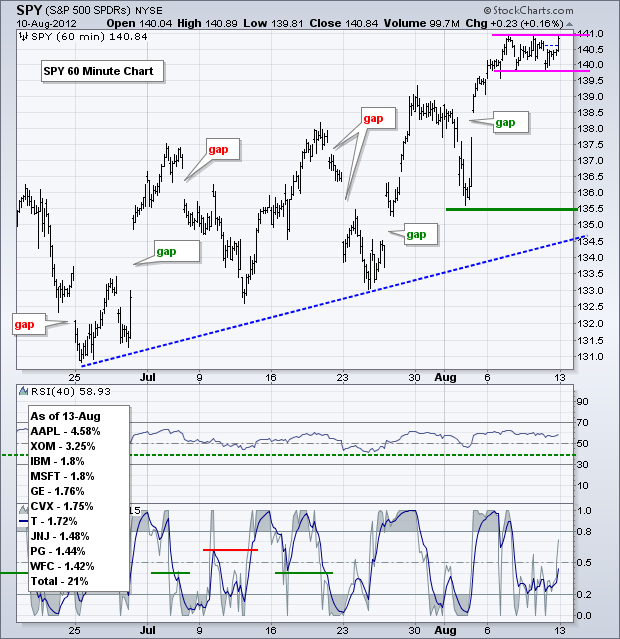
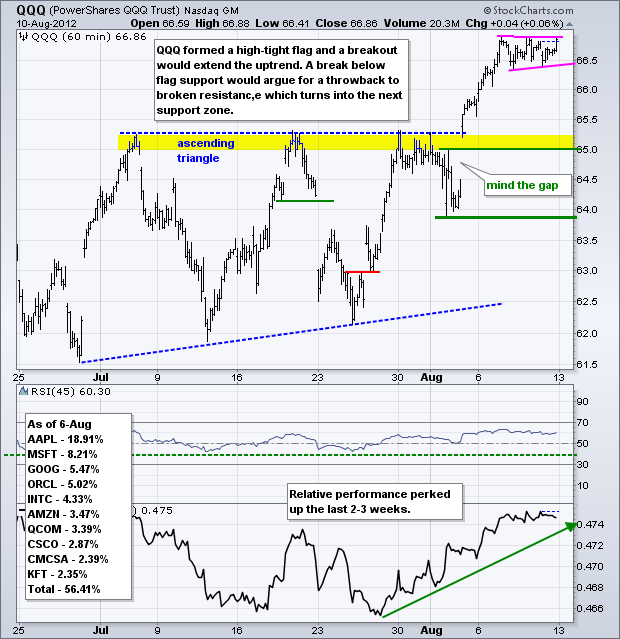
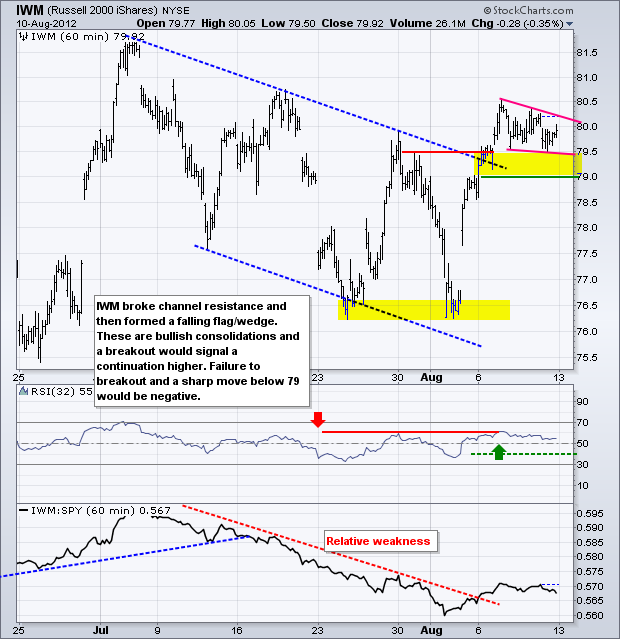
**************************************************************************
Stocks are short-term overbought and treasuries are short-term oversold. It is a big week on the economic front and any disappointments would push money into treasuries. The 20+ Year T-Bond ETF (TLT) is bouncing off support in the 124 area. This support zone extends back to June and marks a solid support level on the daily chart. TLT reversed intraday on Thursday and bounced on Friday. This could be the start of an oversold bounce. A worse-than-expected retail sales report would be bullish for treasuries and bearish for equities.

**************************************************************************
The Dollar, and by extension the Euro, could hold the key for gold and stocks. Strength in the Dollar would be negative for stocks and gold, while weakness would be positive. The big trend for the US Dollar Fund (UUP) is up with support on the daily chart set around 22.40 from the June lows. The short-term trend is down as a falling wedge takes shape. UUP bounced within this wedge, but we need to see follow through for a breakout to reverse this downtrend. RSI resistance is set at 60.
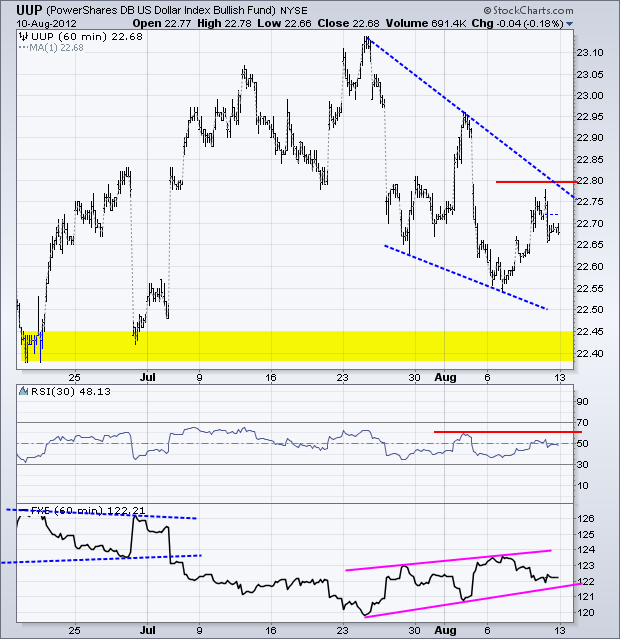
**************************************************************************
As with the various stock indices, the US Oil Fund (USO) consolidated after a sharp gain. A falling flag formed with resistance around 35. A breakout would signal a continuation higher and we could then see a move to the upper 30s. Of course, the direction of oil will depend on the Dollar and stock market. A weak Dollar and strong stock market would facilitate a breakout, while a strong Dollar and weak stock market would lead weigh. The late June trend line and broken resistance mark first support in the 33.5 area. RSI support is set in the 40-50 zone.
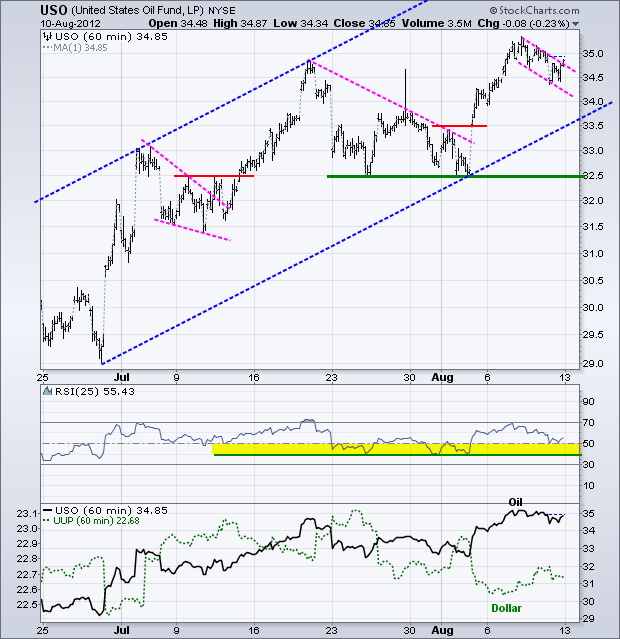
**************************************************************************
The Gold SPDR (GLD) has a potential ascending triangle working since late June. Notice the rising troughs and relatively equal peaks in the 157.5-158 area. This is a potentially bullish pattern and a breakout would target a move to the 165 area. Failure to breakout and a move below 156 would be negative. Note that GLD has been range bound since late May with the Bollinger Bands narrowing on the daily chart. This means we could see a break, one way or the other, soon.
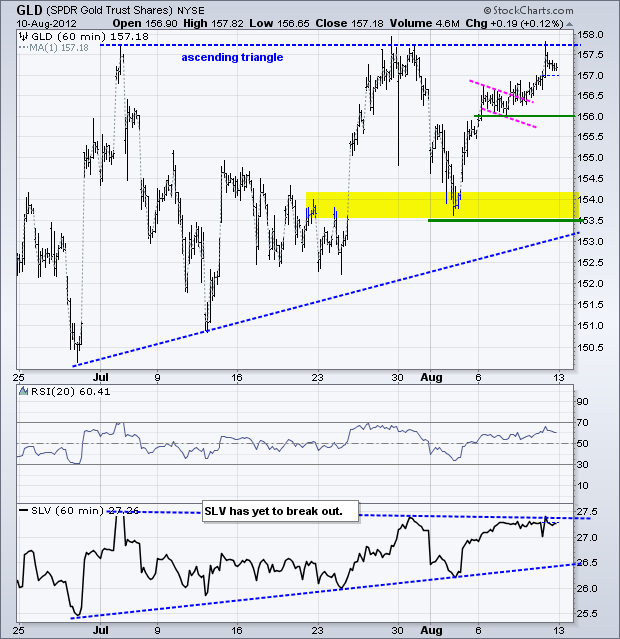
**************************************************************************
Key Reports and Events:
Tue - Aug 14 - 08:30 - Retail Sales
Tue - Aug 14 - 08:30 - PPI
Tue - Aug 14 - 10:00 - Business Inventories
Wed - Aug 15 - 08:30 - CPI
Wed - Aug 15 - 08:30 - Empire Manufacturing
Wed - Aug 15 - 09:15 - Industrial Production
Wed - Aug 15 - 10:00 - NAHB Housing Market Index
Wed - Aug 15 - 10:30 - Crude Inventories
Thu - Aug 16 - 08:30 - Initial Claims
Thu - Aug 16 - 08:30 - Housing Starts/Building Permits
Thu - Aug 16 - 10:00 - Philadelphia Fed
Fri - Aug 17 - 09:55 - Michigan Sentiment
Fri - Aug 17 - 10:00 - Leading Economic Indicators
Fri – Aug 31 – 09:00 – Jackson Hole Central Bank Symposium
Charts of Interest: Tuesday and Thursday
This commentary and charts-of-interest are designed to stimulate thinking. This analysis is not a recommendation to buy, sell, hold or sell short any security (stock ETF or otherwise). We all need to think for ourselves when it comes to trading our own accounts. First, it is the only way to really learn. Second, we are the only ones responsible for our decisions. Think of these charts as food for further analysis. Before making a trade, it is important to have a plan. Plan the trade and trade the plan. Among other things, this includes setting a trigger level, a target area and a stop-loss level. It is also important to plan for three possible price movements: advance, decline or sideways. Have a plan for all three scenarios BEFORE making the trade. Consider possible holding times. And finally, look at overall market conditions and sector/industry performance.

About the author:
Arthur Hill, CMT, is the Chief Technical Strategist at TrendInvestorPro.com. Focusing predominantly on US equities and ETFs, his systematic approach of identifying trend, finding signals within the trend, and setting key price levels has made him an esteemed market technician. Arthur has written articles for numerous financial publications including Barrons and Stocks & Commodities Magazine. In addition to his Chartered Market Technician (CMT) designation, he holds an MBA from the Cass Business School at City University in London.
Learn More
